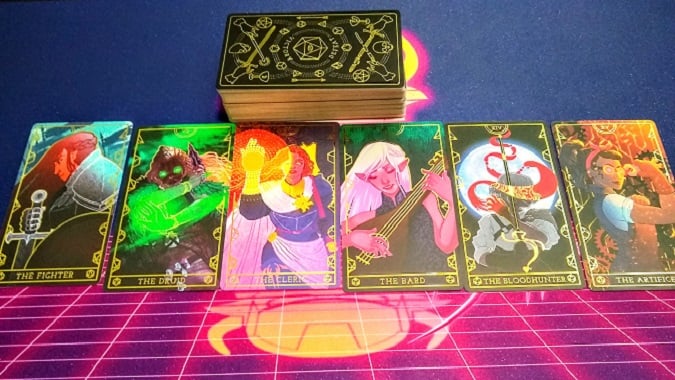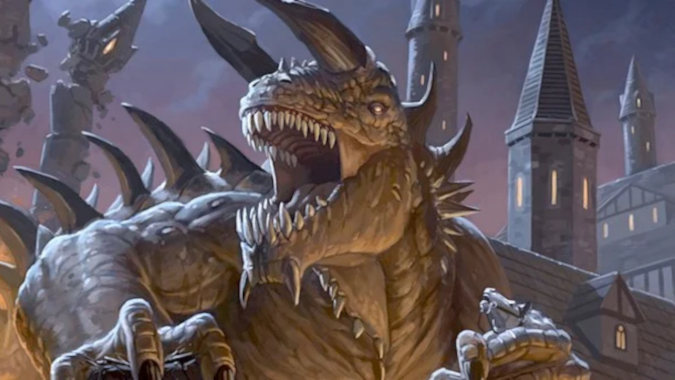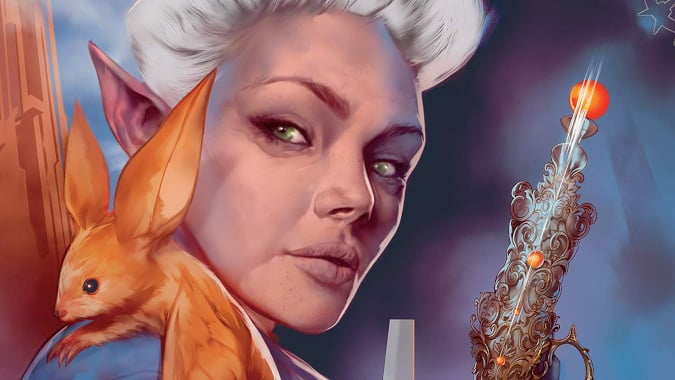Why you should consider the Deck of Many Things for your next TTRPG game

The Deck of Many Things, also sometimes known as the Deck of Hazards, is a magic item that started its life in the very first supplement for Dungeons and Dragons. In 1975, with the release of Greyhawk, the original version of the deck was introduced, containing 18 cards containing the royal suits and two jokers from a standard playing deck. In 1979, it was again introduced in the first Dungeon Master’s Guide, and came in two different styles — a 13 card deck or a 22 card deck. In 1983, an official 78 card tarot deck of many things was released in Dragon Magazine.
The deck represented an incredibly powerful magical relic that was often whispered about at the tabletops scattered throughout the land, and for good reason. No matter the version, throughout the years, the deck has been something that could grant wishes, change alignments of characters, grant players obscene wealth, but also transport them to other dimensions or make them fight Death in a 1-v-1 face-off. The effects were varied, and often very powerful but almost always very wild.
The reputation of the deck is, to be honest, fairly well known — and oftentimes sinister. As a result, DMs have a tendency to shy away from it for fear of what it will do to a party. I’ve seen player groups who have been given it and refuse to use it under any circumstances. But I would like to propose to you, dear readers, that if you are running a game you may want to consider actually using the Deck of Many Things.

You control the power
The first thing that I need to remind you, is that if you are running the game. You control the power level of the cards and what they do, and how they interact with the players and your game world. The biggest mistake I see when someone decides to use the Deck is that they feel they have to be governed by the exact letter of the cards. Instead, I recommend using it as a set of guidelines for the most part.
Let me give you some examples.
- The Fates: When drawn, the player gains the ability to undo the fabric from time and reality, completely erasing one event from their life as if it never happened (including curses).
This is potentially a very powerful card when drawn, but it only undoes a single event. That event can have multiple ramifications and could also be the catalyst for players to maybe regain something that was lost. You can help steer the direction of this, and also dictate how the event was reversed. You get to say how it happens, the player gets to choose what it was that gets reversed.
- Moon: They gain the ability to cast the powerful spell wish in one to three instances
Arguably the most powerful card in the entire deck, the wish spell lets players duplicate any spell in the entire game of 8th level or lower, can create vast wealth, heal everyone instantly, undo a recent event just like The Fates, or the players can make a wish just like in the old stories.
This is one of the best and worst things that can happen, and it falls to you to interpret the wish. Players can be as specific as they want but like with the Fates, it is your job to have it make sense in context of your game world.
At the end of the day, if you’re running the game, as powerful as some of these cards can be you have ultimate say on what that actually means!

Source of story points and fun twists
One of my favorite things about the deck is how it can help provide unexpected plot twists or strange story points that can just be wild and fun. You never know truly how a player will react to awesome power, or awesome loss, and it gives you so many opportunities.
In the campaign that I ran before the current Otherweald game I’m running for the crew here, my group of players was very rowdy and with two exceptions were not very experienced. I had a player, Walter the Bard, who was all about the hustle — being the face, getting the best deal and ultimately opening up a Casino in the middle of the main hub city. The person playing Walter adored the idea of big stakes.
As the party was clearing out a dungeon, a mansion that a previous player in the campaign had built and retired to, they happened upon the adventurer’s gallery. Under heavy spelled glass was a deck of cards. Walter honed in on it and got his hands on it. When he did so, I handed him a physical deck of cards with the rules that he could draw 1-3 cards per long rest. I saw the glint in his eye and we were, as they say, off to the races. Walter — and his Deck — went through the largest character arc. The deck saved a party member, transported him to the elemental plane of air, caused him to lose his fortune, caused him to gain another fortune, caused him to change alignments and so many more things. It was incredibly memorable and the party would encourage him to draw every session, sometimes in the middle of a boss fight! In fact, in their darkest hour Walter drew the last card, which allowed him to save the party from death in their final fight with the Big Bad. Completely unexpected, but supremely memorable events that the players still talk about to this day.

Don’t limit yourself to fantasy or the system
One of the traps I think with the Deck of Many Things is that it’s often viewed as a fantasy-only item, or in truth a D&D only item. I challenge that line of thought. It can easily be slotted into any genre, or game system, if you think about it. Maybe instead of a deck of cards, it’s a game on a computer in a Cyberpunk Dystopia that alters reality or influences machines and tech around the players. Who wouldn’t want evil solitaire? Shadowrun seems to have it built right in, as it is a game of tech and magic. Every effect that the Deck of Many Things has can be adapted pretty easily, as they are at this point mostly generic. I’ve used it in many games and many systems. It’s always fun and produces some extremely wild twists and turns.
Don’t be afraid to explore this wonderous item. It can be as powerful or as weak as you want, and can give you some great inspiration in your next tabletop game. I personally think it is time for this item to start making a comeback.
Please consider supporting our Patreon!
Join the Discussion
Blizzard Watch is a safe space for all readers. By leaving comments on this site you agree to follow our commenting and community guidelines.





